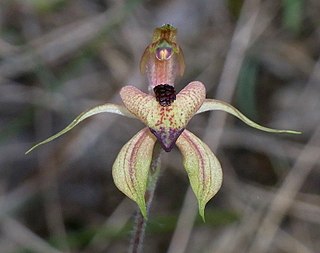
Caladenia angustata, commonly known as white caps is a species of orchid endemic to Tasmania. It has a single, hairy leaf and one or two white to pinkish flowers which are reddish or greenish on their backs. It has not been accepted as a separate species by some authorities who regard it as a synonym of Caladenia gracilis.

Caladenia saccharata, commonly known as sugar orchid, is a species of flowering plant in the orchid family, Orchidaceae and is endemic to the south-west of Western Australia. It has a single leaf and a single flower with three white sepals and two similar petals.

Caladenia gracilis, commonly known as musky caps or musky caladenia, is a plant in the orchid family Orchidaceae and is endemic to eastern and south-eastern Australia, including Tasmania. It is a ground orchid with a single leaf and up to six flowers which are dark-coloured on the back and white on the front, sometimes tinged with pink and with a strong musky or soapy odour. The species is also known as Caladenia moschata in Victoria.

Caladenia barbarossa, commonly known as the common dragon orchid is a species of orchid endemic to the south-west of Western Australia. It can be distinguished by its distinctive labellum which is attractive to species of male thynnid wasps.

Caladenia cardiochila, commonly known as thick-lipped spider-orchid, fleshy-lipped caladenia and heartlip spider-orchid, is a plant in the orchid family Orchidaceae and is endemic to Victoria and South Australia. It is a ground orchid with a single hairy leaf and one or two yellowish-green, red-striped flowers on a thin, wiry stem.
Caladenia dienema, commonly known as the windswept spider-orchid, is a plant in the orchid family Orchidaceae and is endemic to Tasmania. It is a ground orchid with a single, hairy leaf and a single, variably-coloured, usually dark red flower on a thin, wiry stem 5–12 cm (2–5 in) high.

Caladenia echidnachila, commonly known as the fawn spider orchid, is a plant in the orchid family Orchidaceae and is endemic to Tasmania. It is a ground orchid with a single, hairy leaf and one or two fawn-coloured flowers with thin red lines on the sepals and petals.

Caladenia fragrantissima, commonly known as the scented spider orchid, is a plant in the orchid family Orchidaceae and is endemic to Victoria and South Australia. It is a ground orchid with a single hairy leaf and up to three creamy-white to yellowish-green flowers. It is possible that it is conspecific with Caladenia orientalis.
Caladenia hastata, commonly known as Mellblom's spider orchid is a plant in the orchid family Orchidaceae and is endemic to Victoria. It is a ground orchid with a single hairy leaf and up to three white to cream-coloured flowers with red markings on the labellum.
Caladenia helvina, commonly known as the summer spider orchid, is a plant in the orchid family Orchidaceae and is endemic to Tasmania. It is a ground orchid with a single hairy leaf and usually a single greenish-yellow to pale yellow flower with reddish teeth on the sides of the labellum and reddish calli along its mid-line.

Caladenia huegelii, commonly known as the grand spider orchid is a species of orchid endemic to the south-west of Western Australia. It has a single, hairy leaf and up to three relatively large red, green and cream-coloured flowers which have "split-hairs" on the sides of the labellum.

Caladenia multiclavia, commonly known as the lazy spider orchid is a species of orchid, endemic to the south-west of Western Australia. It has a single, hairy leaf and one or two greenish-yellow, red and cream-coloured flowers resembling a reclining spider. Although it usually only has a single flower, it often grows in clumps of up to six plants.
Caladenia osmera is a plant in the orchid family Orchidaceae and is endemic to south-eastern Australia. It is a ground orchid with a single leaf and one or two greenish-cream flowers with pink stripes and which has a sharp odour resembling burnt plastic.
Caladenia patersonii is a plant in the orchid family Orchidaceae and is native to Victoria and Tasmania. It is a ground orchid with a single hairy leaf and one or two creamy-white, yellowish or pink flowers.
Caladenia peisleyi is a plant in the orchid family Orchidaceae and is endemic to south-eastern Australia. It is a ground orchid with a single leaf and a single greenish-yellow flower with pale red stripes. It is difficult to distinguish from several other Caladenia species.

Caladenia septuosa, commonly known as the Koppio spider orchid, is a plant in the orchid family Orchidaceae and is endemic to South Australia. It is a ground orchid with a single erect, sparsely hairy leaf and usually only one greenish-cream flower with red stripes along the sepals and petals.

Prasophyllum fimbria, commonly known as the fringed leek orchid, is a species of orchid endemic to the south-west of Western Australia. It is a tall orchid with a single smooth, tube-shaped leaf and up to seventy greenish-brown flowers with a white and pink labellum.

Prasophyllum lindleyanum, commonly known as the green leek orchid, is a species of orchid endemic to south-eastern Australia. It has a single smooth, tube-shaped leaf and up to twenty scented, greenish flowers with a greenish or white labellum with a pink tinge.

Prasophyllum brownii, commonly known as the Christmas leek orchid, is a species of orchid endemic to the south-west of Western Australia. It is one of the last of the genus in Western Australia to flower and has a tall flowering stem with up to eighty pale green and fawn-coloured flowers.
Prasophyllum cucullatum, commonly known as the hooded leek orchid, is a species of orchid endemic to the south-west of Western Australia. It is a tall orchid with a single smooth, tubular leaf and up to fifty or more purplish-red and white flowers with a frilled labellum crowded along a relatively short flowering stem.






















